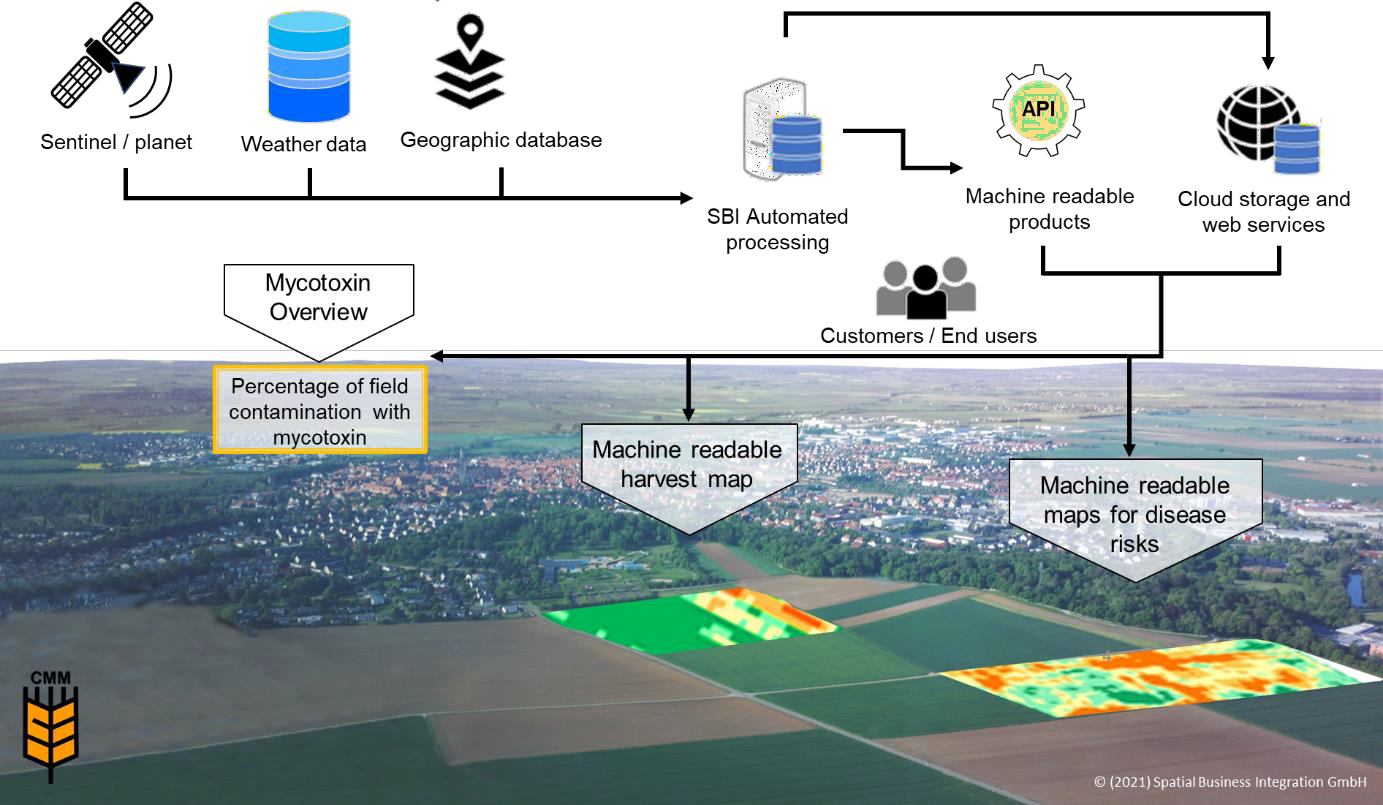
Objectives of the service

Wheat plays a major role in feeding a growing population and is one of the most important pillars of global food security by providing about 20% of the total dietary calories and proteins worldwide. Mycotoxigenic fungal diseases like Fusarium head blight (FHB) are a major concern in wheat cultivation since they can significantly reduce the quality and quantity of consumable production. Around 25% of the global wheat cultivation area is thereby estimated at risk for mycotoxin contaminations due to optimal environmental conditions. Despite efforts in wheat breeding and controlling fungal infection, mycotoxigenic fungi are still one of the most important pathogens of significance. In this context CMM provides the following services based on satellite EO imagery:
- Disease risk maps showing the in-field risk zones of the most important wheat diseases during the vegetation period. Such maps support the selective application of fungicide and reduce the total amount of applied chemicals.
- Site-selective harvest maps that exclude high-risk mycotoxin accumulation zones to secure the overall harvested yield.
- Mycotoxin overview that includes an estimation (%) of the field area at risk of mycotoxin contamination after harvest. Such overview can provide commodity traders with early insight into their purchasable production.
Users and their needs
Within the study four potential customers (agrochemical companies and cereal traders) from Germany and France have been involved. These entities defined the following needs and requirements:
- Disease scouting support
- Machine-readable application maps for selective spraying which requires user-adjustable dose rates
- Maps showing the mycotoxin contamination risk zones within a field
- Machine-readable harvester map for selective harvesting to exclude infected field zones
- Maps of regional mycotoxin accumulation with figures in ha
These information products shall be delivered on a regular basis and during sensitive crop growing stages. The disease risk and application’s map will be delivered 4 times during the vegetative growth stage while the harvester map at ripening stage. The map of regional mycotoxin accumulation is to be delivered at harvest.
Particularly challenging is to provide the required map accuracy of > 90 % and the timely delivery of the information products, since the usage of optical imagery can be limited due to clouds.
Service/ system concept
CMM is a seasonal cloud-based solution with a flexible framework to integrate EO and terrestrial data for the processing and provision of information products that support mycotoxin management for wheat production. The systems integrate all required input data including satellite imagery, weather data and field boundaries, computes the information products through an automized processing pipeline and delivers the information products to the customer via API. Thereby the system is designed to meet the requirements of different customer segments involved in wheat production and trading. The system includes three submodules (Figure 1) which process and provide i) machine-readable maps for disease risks during the growth of wheat canopy, ii) machine-readable harvesting map and iii) mycotoxin accumulation overview after harvest.

Space Added Value
The use of earth observation satellite imagery enables the monitoring of fields and regions which is of great importance for supporting the efforts for mycotoxin free wheat production and harvesting. The automated integration of satellite imagery enables the provision of services in near-real-time delivery systems.
Satellite images of Sentinel-1 and -2, Landsat-8 and PlanetScope are the main satellite data sources that feed the algorithms of CMM. Geographical database and maps for the area of interest which for example provides the topographical information is another type of input data.
The main intention is to ensure systematic and routine operational activities with a high level of automation and pre-defined operations to the maximum extent possible on a global scale provision of CMM services. All already established services that are targeting crop disease are weather-based forecasting models. The added value of CMM is identifying heterogeneity within fields in terms of the actual biomass, long term averaged biomass and canopy water content that can be estimated using satellite imagery data. Based on those recommendations for site-specific application of fungicides and harvesting can be generated instead of handling the entire field non-selectively. That in turns reduces the cost of production, maintains the environment and reduces the loss of yield.
Current Status
SBI has engaged with four potential customers. Their expectations towards t technical, operational and commercial aspects of the service have been captured in order to define a sustainable product covering their needs. Further communication is still continuously ongoing to engage with more potential customers with the aim to sharpen the service and to broaden the potential customer base for the demonstration phase.
Based on identified user needs from agrochemical companies and traders, the services of CMM including disease risk maps, mycotoxin harvesting maps and mycotoxin overview have been technically defined and processing chains have been developed.
The prices for the envisaged services have been set and a business plan for sustainable service provision has been elaborated. It is expected that the so far involved customers are willing to buy the services if they are reliable and do not exceed the requested price.
CMM was successfully completed in July 2021.



